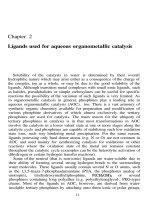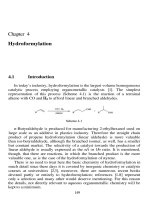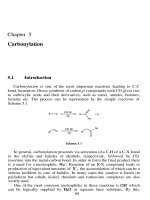Tài liệu Chapter 5: Carbonylation pdf
Bạn đang xem bản rút gọn của tài liệu. Xem và tải ngay bản đầy đủ của tài liệu tại đây (502.59 KB, 17 trang )
Chapter 5
Carbonylation
5.1 Introduction
Carbonylation is one of the most important reactions leading to C-C
bond formation. Direct synthesis of carbonyl compounds with CO gives rise
to carboxylic acids and their derivatives, such as esters, amides, lactones,
lactams etc. The process can be represented by the simple reactions of
Scheme 5.1.
In general, carbonylation proceeds via activation of a
C-H or a C-X bond
in the olefins and halides or alcohols, respectively, followed by CO-
insertion into the metal-carbon bond. In order to form the final product there
is a need for a nucleophile, Reaction of an R-X compound leads to
production of equivalent amounts of the accumulation
of which can be a
serious problem in case of halides. In many cases the catalyst is based on
palladium but cobalt, nickel, rhodium and ruthenium complexes are also
widely used.
One of the most common nucleophiles in these reactions is which
can be logically supplied by or aqueous base solutions. By this,
191
192
Chapter 5
aqueous organometallic catalysis gets a special flavour, since water now is
not only a solvent but one of the reactants. Aside chemistry this means, that
the amount of water in such systems may vary from stoichiometric
quantities (usually homogeneously dissolved in the organic solvent or in the
substrate of the reaction) to larger volumes, in form of a separate aqueous
phase. Although both kinds of reaction media are “aqueous”, in the
following we shall mostly quote examples of the second variant. In such
aqueous/organic biphasic systems the catalyst can be dissolved in the
organic or in the aqueous phase, and we shall include both methods into our
description, since water is essential in both cases.
This is also a field of chemistry, where biphasic and phase transfer-
assisted organometallic catalysis [11-12] are very close and sometimes may
even overlap. One reason for this closeness is in that inorganic bases are
often used in aqueous solutions. Of them, is so strongly solvated in
water that it will practically not transfer to non-polar organic solvents
without a phase transfer (PT) agent, e.g. a quaternary ammonium cation.
However, some reactions proceed readily with dissolved in the organic
phase, or can take place with reasonable rates at the liquid-liquid interface,
and in these cases addition of PT catalysts is not essential.
In addition to this chapter, there are several books and reviews [1-8]
which –inter alia– deal with carbonylations with CO and two of them
[9-10] specifically addressed to this topic.
5.2 Carbonylation of organic halides
Allyl chlorides and bromides can be carbonylated to afford the respective
unsaturated acids and esters with a variety of catalysts under relatively mild
conditions such as 30-50 °C and 1 bar CO (Scheme 5.2). Most prominent are
the palladium-containing catalysts and both or
and were used, dissolved in the aqueous
and in the organic phases, respectively [14-16].
When aqueous NaOH is given as a base, isomerization of the product
butenoic acids can be extensive depending on the nature and concentration
of base. In dilute aqueous solutions alcohols do not react to form the
respective esters, however, the reactions are strongly accelerated due to the
increased solubility of the substrates in the catalyst-containing aqueous-
alcoholic phase. For example, with 23-33 % (v/v) ethanol in water the
hydroxycarbonylation of allyl chloride
proceeded with TOF-s of and with a vinylacetic/crotonic acid
ratio of 21 [16]. Addition of increased the overall conversion rate
(by a factor of 2 at ) but at the same time the side reactions
5.
Carbonylation
193
were also accelerated so the selectivity for butenoic acids dropped from 92
to 62 %.
In the carbonylation of allyl halides the highly toxic catalyst
could be replaced by which yielded under the
reaction conditions [17]. The cyanotricarbonylnickel(0) anion is a versatile
catalyst of carbonylations under phase transfer conditions [18], however,
hydroxycarbonylation of allyl chloride proceeds effectively without PT
catalysts in a genuine biphasic system, as well.
Benzyl halides are easily carbonylated to phenylacetic acid derivatives
which are valuable intermediates for Pharmaceuticals, cosmetics and
fragrances [2,3]. Several papers report the aqueous/organic biphasic
realization of this reaction [1,19-22] (Scheme 5.3). The main characteristics
of these processes are summarized in Table 5.1.
194
Chapter 5
The mechanism of palladium-catalyzed carbonylation of organic halides
is generally assumed to involve oxidative additon of R-X to a Pd(0) species
which is formed from the precursors on the action of Migratory
insertion of R onto a coordinated CO followed by reaction with a
nucleophile generates the product and gives back the catalytically active
palladium(0) species (Scheme 5.4 A).
The mechanistic suggestion depicted on Scheme 5.4 may be true in an
excess of phosphine ligands, and in fact, the [phosphine]/[palladium] ratio
has a pronounced influence on the rate and selectivity of the reactions.
However, it has also been demonstrated [20,58] that the palladium(II)-
phosphine complexes used as catalyst precursors are reduced to Pd(0) in the
5. Carbonylation
195
presence of and in the absence of excess ligand, monophosphine
species and their dimers can also participate in the catalytic cycle (Scheme
5.4 B).
Benzyl halides are usually carbonylated using an excess of a base and
then the product is deprotonated and accumulates in the aqueous phase; with
a water-insoluble catalyst, such as this gives a possibility of
catalyst-product separation. It was discovered not long ago [20], that with
Pd/BINAS as catalyst the carbonylations proceeded smoothly even at pH 1.
According to this method, slightly less than stoichiometric amount of base is
used and then the final pH of the aqueous phase is strongly acidic due to the
formation of HCl in the carbonylation reaction. At this pH 99 % of the
phenylacetic acid product becomes protonated and moves to the organic
phase, consequently it can be separated from the catalyst. Although the
catalyst in the aqueous phase can be reused, accumulation of NaCl in
successive runs generates additional problems. The Pd/TPPTS catalyst
cannot be used this way due to precipitation of palladium black when all the
substrate is consumed.
Mono- and double carbonylation of phenetyl bromide with cobalt-
phosphine catalysts afforded benzylacetic (Baa) and benzylpyruvic (Bpa)
acids respectively [23] (Scheme 5.5). The highest yield of benzylpyruvic
acid (75 %) was obtained with while addition of the water
soluble phosphines TPPMS or TPPTS decreased both the yield of
carbonylated products and the selectivity to Bpa.
Carbonylation of aromatic halides is of great industrial interest and
several efforts were made to produce the corresponding benzoic acids in
aqueous (biphasic) reactions. The tendency of an aromatic C-X bond to
react in an oxidative addition onto Pd(0) as required by the reaction
mechanism (Scheme 5.4) decrease in the order so much that
chloroarenes are notoriously unreactive in such reactions.
Water-soluble aryl iodides can be easily carbonylated under mild
conditions (Scheme 5.6) using as base [24]. The same does not hold
196
Chapter 5
for water-insoluble iodoarenes which require higher temperature (100 °C) to
proceed. The latter, however, can be oxidized to iodoxyarenes by
simple stirring with sodium hypochlorite (household bleach), slightly
acidified with acetic acid. The resulting iodoxyarenes can be efficiently
carbonylated with as catalyst under very mild conditions (40 °C,
1 bar); iodobenzene and nine substituted iodobenzenes were carbonylated
with excellent yields in such two-step biphasic procedures [25].
Carbonylation of bromobenzene (Scheme 5.7) with
required still higher temperatures (150 °C). The possible acyl intermediates
of such reactions and
were synthetized and characterized [26]. Bromobenzene was also
carbonylated to benzoic acid in water/toluene using a catalyst prepared from
and
27
in the presence of [21].
An exceptionally simple procedure was developed for the catalytic
carbonylation of chloroarenes using as catalyst. According to
this method the neat chloroarene, e.g. m-chlorotoluene and the catalyst are
stirred with 20 % (w/w) aqueous KOH at reflux temperature with bubbling
CO. The benzoic acids are extracted from the aqueous phase after









